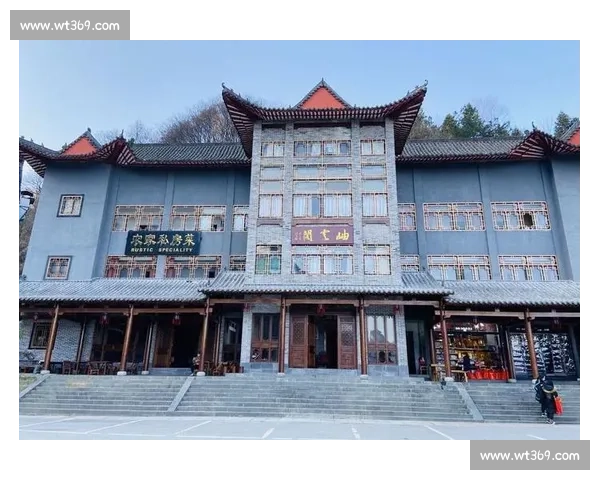Wudang Mountain Where Taoism Meets Architectural Grandeur
Introduction to Wudang Mountain
Nestled in Danjiangkou City, Hubei Province, Wudang Mountain stands as more than just a geological landmarkвАФit is a living repository of Chinese Taoism, architectural genius, and martial arts heritage. Recognized as a UNESCO World Heritage Site in 1994, this sacred mountain has captivated emperors, monks, and travelers for over a millennium, weaving together nature and human ingenuity into a tapestry of "celestial palaces amid clouds".
The story of Wudang Mountain is inseparable from its йБУжХЩ (Taoist) roots. As the foremost of ChinaвАЩs four great Taoist mountains, its spiritual legacy dates back to the Spring and Autumn Period, when hermits first sought enlightenment in its secluded valleys. By the Tang Dynasty (627-649 CE), Emperor Taizong had commissioned the Five Dragon Shrine, laying the foundation for what would become a royal sanctuary. The mountainвАЩs golden age arrived in the Ming Dynasty, when Emperor Chengzu жЬ±ж££ (Zhu Di) launched a 12-year construction campaign involving 300,000 craftsmen and soldiers. By its completion, 33 grand complexesвАФincluding 9 palaces, 8 temples, and 72 cliffside shrinesвАФstretched 140 miles across the landscape, each site carefully aligned with the myth of Zhenwu, the Taoist God of Water who purportedly attained immortality here.

What makes WudangвАЩs architecture unparalleled is its fusion of imperial grandeur and Taoist philosophy. Following Zhu DiвАЩs edict that "not a single inch of the mountain shall be altered," builders adapted to the terrain rather than reshaping it, creating structures that seem to emerge naturally from cliffs and slopes. The Tianzhu Peak (Heavenly Pillar), rising 1,612 meters above sea level, is crowned by the Golden PalaceвАФa masterpiece of gilded bronze craftsmanship forged in 1416. Despite five centuries of wind and rain, its surfaces still glow like new under the sun, embodying the Taoist pursuit of eternal harmony. Below it, the Purple Cloud Palace (Zixiao Gong) preserves the largest painted wooden statues of Zhenwu and his attendants, while the Fuzhen Guan (Return to Truth Temple) showcases the "Nine-Turn Yellow River Wall" and the five-story Wuyun Building, famous for its "one pillar supporting twelve beams" wooden jointвАФa marvel of ancient engineering. Even the mountainвАЩs entrance, the "Zhishi Xuanyue" Memorial Archway, carries symbolic weight: its 11.9-meter stone frame, carved with cloud patterns, declares WudangвАЩs role as a bridge between earthly rule and divine order.
Beyond stone and wood, Wudang Mountain gave birth to a martial art that mirrors its Taoist essence. Legend credits the Taoist priest Zhang Sanfeng with creating Neijiaquan (Internal Martial Arts) here, a system that prioritizes softness over force, stillness over motion. Unlike the aggressive external styles, Wudang kung fu draws on theYijing(Book of Changes) and Taoist energy cultivation (Neidan), using circular movements to channel internal qi (energy) and "overcome hardness with softness". Taijiquan, Liangyi Quan, and Wudang Sword are its most renowned expressions, each movement flowing like waterвАФreflecting the mountainвАЩs streams and mistsвАФwhile strengthening both body and spirit. For practitioners, Wudang kung fu is more than self-defense; it is a path to aligning with the Taoist principle ofTianren Heyi(unity of heaven and humanity).
Today, Wudang Mountain remains a sanctuary of living tradition. Its 53 surviving ancient buildings and 5,035 cultural relics are meticulously preserved, while Taoist monks continue to perform rituals in temples like Nanyan Gong, where the Two дї™ Hall (Liangyi Dian) blends filial piety with spiritual devotion by honoring ZhenwuвАЩs parents. Hikers trace stone paths once trodden by emperors, passing relics like the 16th-century "Zhishi Xuanyue" Archway and the ruins of Yuxu Palace, which once rivaled the Forbidden City in scale. In spring, azaleas carpet the valleys below the Golden Palace; in winter, snow turns the red-walled temples into scenes from a Taoist scroll.
MILE米乐,mile官网,MILE米乐集团,MILE米乐官网Wudang Mountain is more than a tourist destinationвАФit is a testament to ChinaвАЩs ability to harmonize power, faith, and nature. Its palaces, forged by imperial decree yet humbled by the mountains; its martial arts, born from solitude yet shared with the world; its Taoism, ancient yet alive in every incense curlвАФall converge to make it a place where the divine feels tangible. To stand atop Tianzhu Peak at dawn, watching sunlight gild the Golden Palace and mist rise from the valleys, is to understand why for a thousand years, Wudang has been called "the most sacred mountain under heaven."
иЛ•дљ†иІЙеЊЧеЖЕеЃєйЬАдЊІйЗНжЯРйГ®еИЖпЉИе¶Вж≠¶жЬѓзїЖиКВгАБеїЇз≠СеЈ•иЙЇжИЦйБУжХЩдї™еЉПпЉЙпЉМжИЦжГ≥и∞ГжХіиѓ≠и®Ай£Ож†Љдї•жЫіиііеРИеПВиµЫйЬАж±ВпЉМ搥ињОйЪПжЧґеСКзЯ•пЉМжИСеПѓињЫдЄАж≠•дЉШеМЦеЃМеЦДгАВ

еПСи°®иѓДиЃЇ